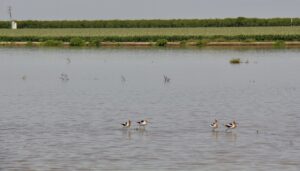The atmospheric river that pummeled Northern California late last week brought welcome relief from the drought and not just in inches of rainfall.
It was also a sign that the Ridiculously Resilient Ridge (a.k.a. The RRR), which at this time last year was mounting a formidable force over our skies by directing the Pacific jet stream well to the north, has not reared its ugly head in any kind of persistent manner at the start of the 2014-2015 rainy season.
“The RRR is nowhere to be seen right now, which is great news from a drought perspective,” said Daniel Swain, a doctoral candidate in Environmental Earth System Science at Stanford University, who coined the term ‘RRR’. “That’s not to say with absolute certainty that it won’t return later this winter, but this December’s pattern over the Eastern Pacific is almost exactly the opposite of last year. We’ll make up for our dry fall over the next week or so.”
The jet stream pointed directly our way and delivered three inches-plus to Northern California from a narrow plume of tropical moisture more than 3,000 miles long. This was billed as the largest storm in wind and rain intensity since January 2008, and considering that we need five or six of these large storms to make a California water year “normal,” it’s both a good start to the rainy season, yet hardly the final word on the drought.
As we huddle under umbrellas and crank up our heaters, it’s a funny time to continually debate California’s epic drought. And yet that’s what scientists have been doing lately, as more research has come out on the causes and significance of the failure of rains over the past three years. Climate change is the boogeyman in the room, and rightfully so because it speaks to our ability to predict future droughts and to understand why we’re in this pickle.
Scientists normally shy from attributing any particular weather event to climate change, but in the growing field of “climate attribution,” they are beginning to take the next step and are even doing real-time analysis of weather events and their potential climate change connections.
Last week, scientists from the National Oceanic and Atmospheric Administration and the Lamont-Doherty Earth Observatory at Columbia University made global headlines in a published report that placed California’s drought in the realm of natural variability with no clear climate change signal, at least when it comes to the inches of precipitation that fell (drought intensity is a different matter, and was particularly bad this year because of the combination of record low rainfall and record high temperatures).
The research team ran simulations using seven climate models, and found that “purely atmospheric-driven variability” accounted for more than half of the drought’s intensity.
Meanwhile, rising sea surface temperatures in parts of the Pacific, presumably more solidly linked to climate change, was a lesser, although still significant driver of the drought, the research team concluded. But even that’s not clear, in terms of what the models were able to capture.
“This requires a serious effort to better understand the SST (sea surface temperature)-forcing that is important for California …,” the research team wrote.
The team based its conclusions, in part, on the fact that the models they used show that climate change will increase California’s precipitation during the mid-winter, making for a wetter winter climate, not a dryer one.
“The recent, severe all-winter rainfall deficit is thus not a harbinger of future precipitation change,” the research team wrote.
Swain co-authored his own study a few months back showing that the RRR was three times more likely to form in the presence of modern greenhouse gas concentrations, potentially making drought a more prominent feature in a climate-changed world. Yet, he said that his study and the NOAA/Lamont-Doherty study do not contradict each other, but rather were asking different questions of the climate models.
“One can have an honest debate about which things are the most relevant and most important,” he said.
Swain said his paper focused on the probability of extreme climate events, such as this drought, while the NOAA/Lamont-Dogerty paper placed the drought in the context of long-term averages in precipitation. He said it’s possible that California could see a long-term increase in precipitation, but in the context of extreme weather events, both wet and dry. How the droughts and stormy years pencil out is still an open question. But California, already a land of extremes, will become more so under climate change.
“There’s a pretty strong expectation that variability in many places will increase due to climate change and that could take the form of increased wet events or increased dry events of some combination of the two,” Swain said. “There’s some evidence that this is what’s going on in the models.”
And there’s also the reality that you can’t completely tweak out a “natural” cause from a climate change cause of a drought. Scientists typically view the effects of climate change, such as higher sea surface temperatures, as a “forcing” on the natural system.
“A remaining question is what caused these unusual ocean conditions, which is something we didn’t address in our work,” he said. “It’s almost never going to be one or the other — natural conditions or climate change alone — that result in a drought, or any kind of extreme weather event. Sometimes one can have a greater effect over the other. We have always had big swings — from very dry to very wet — but the real question is how climate change is affecting these swings now and in the future.
So where does all leave us this winter’s rainy season? So far the models predict it will be wetter than last year, but “not necessarily above the climatological normal,” according to the NOAA/Lamont-Doherty report. So while this major storm is providing critical short-term relief, the drought is still on, as you may have already surmised.
Alison Hawkes is the online editor of Bay Nature.





